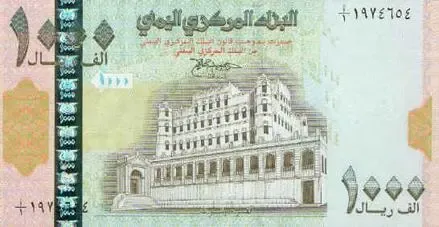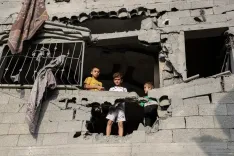Why is the Yemeni Rial Plummeting to Historic Lows?

Synopsis
Key Takeaways
- The Yemeni rial has fallen to an all-time low of 2,760 rials per dollar.
- This decline deepens the humanitarian crisis, affecting millions.
- Public protests have erupted in response to the economic situation.
- Food insecurity threatens nearly 5 million people in Yemen.
- Urgent intervention is required to stabilize the economy and assist affected populations.
Aden, June 29 (NationPress) The Yemeni rial has nosedived to an unprecedented low of about 2,760 rials per U.S. dollar in recent trading, representing the currency's most significant decline since the civil war began in 2015. This situation exacerbates the plight of millions already facing what the UN describes as the world's most severe humanitarian crisis.
The historic collapse of the currency has led to a complete cessation of foreign exchange transactions at currency exchange offices in government-controlled areas over the past weeks. Local banking sources, as reported by Xinhua, indicate that traders are apprehensive of further declines without immediate intervention.
When the conflict in Yemen began in early 2015, the rial was valued at around 215 rials per dollar. The current rate signifies a staggering depreciation of nearly 1,200 percent, severely diminishing the purchasing power of ordinary Yemenis and making essential goods unaffordable for millions.
Economic experts attribute the downfall of the rial to the Yemeni government's intensifying financial troubles, particularly following a halt in oil export revenues since late 2022.
This cessation resulted from Houthi assaults on oil facilities and ports, severing a crucial revenue stream for the cash-strapped government. The Houthis are demanding a comprehensive agreement regarding the sharing of oil revenues and their allocation for nationwide salary payments—an unresolved issue that is further complicating the economic crisis.
The freefall of the rial has ignited public protests, with many residents in the southern port city of Aden demonstrating earlier this month, urging the government to take immediate measures to counter the currency's decline and implement extensive public service reforms.
Hussein Ali, a laborer from Aden, represents the millions struggling in Yemen. Ali, who provides for a family of six, earns around 15,000 rials (approximately $7) daily from construction, agriculture, or carpentry. 'Previously, a worker's salary of 4,000 rials sufficed for all family needs. Now, a day's wage barely covers the price of one kilogram of rice,' he lamented.
'Each day brings more hardship,' Ali expressed. 'As the rial collapses, so does our entire existence.'
Mohammed Al-Mahrabi, an employee at the Ministry of Education, faces similar adversities despite having a seemingly stable job. 'My salary is insufficient for my children's basic food and drink needs. Additionally, salary payments are often delayed for months, leading me to accumulate significant debts,' he stated.
To supplement his income, Al-Mahrabi has taken up taxi driving, yet this too has become unfeasible. 'Fuel prices have surged to 39,000 rials for 20 liters (around $15) and continue to rise. My taxi work can't even cover fuel expenses. I'm exhausted, and even secondary jobs have become pointless,' he explained.
Economic analyst Ramzi Sultan emphasized that the persistent fluctuations in currency value are significantly worsening living conditions. 'The ongoing depreciation of the rial diminishes real wages, intensifies inflation, and results in widespread shortages of essential goods. This diminishes consumer confidence and business activity, accelerates capital flight, and heightens poverty and unemployment,' he clarified.
Sultan attributes the collapse to fundamental imbalances in financial and monetary policy. The government faces dwindling revenues while its expenses and obligations escalate.
The issue is aggravated by the fragmented banking system, with distinct authorities operating in Sana'a and Aden. In Houthi-controlled regions, the dollar is exchanged at around 537 rials using older banknotes that face severe liquidity constraints.
This institutional division has undermined the Central Bank's authority over monetary policy, enabling black market operators to manipulate exchange rates, he added.
The currency collapse further complicates an already desperate humanitarian situation. According to United Nations data, about 80 percent of Yemen's population currently lives below the poverty line, with the economic crisis threatening to plunge millions deeper into destitution.
Recently, three major UN agencies issued urgent alerts regarding escalating food insecurity across Yemen's southern provinces. The Food and Agriculture Organisation, World Food Programme, and United Nations Children's Fund reported that nearly 5 million people in southern Yemen are facing food insecurity, with conditions expected to worsen without immediate intervention.
Without sustained assistance, an additional 420,000 people could fall into severe food insecurity between September and February 2026, potentially increasing the total number of severely food-insecure individuals to 5.38 million—over half the population in Yemen's southern regions.
The agencies highlighted several factors fueling this crisis, including prolonged economic downturn, sharp currency depreciation, ongoing conflict, and increasingly frequent extreme weather events disrupting agricultural production and food distribution.
The current crisis in Yemen is rooted in nearly a decade of catastrophic conflict that began in late 2014 when the Houthi group took control of several northern provinces, forcing the internationally recognized government to flee the capital, Sanaa.
The conflict escalated significantly in 2015 with the intervention of a Saudi-led coalition aimed at reinstating the legitimate government.
Despite numerous international mediation efforts and sporadic ceasefire agreements, a comprehensive and lasting peace settlement remains unattained.









